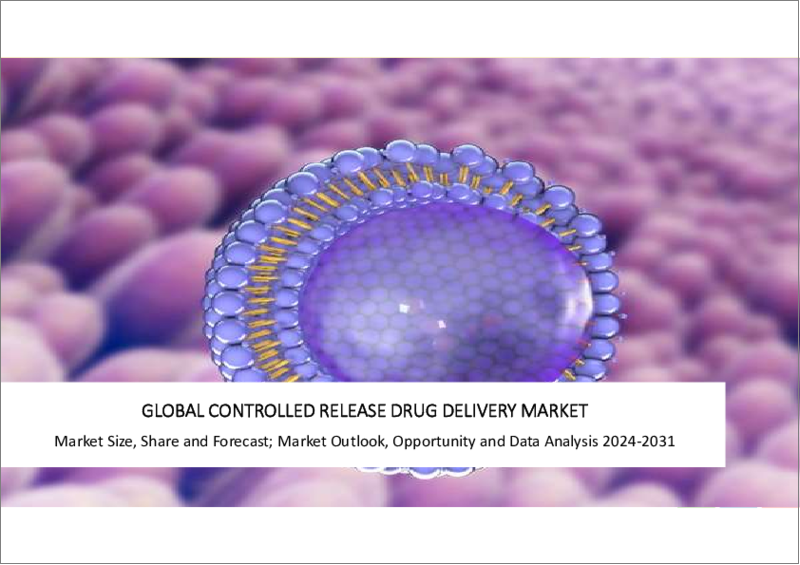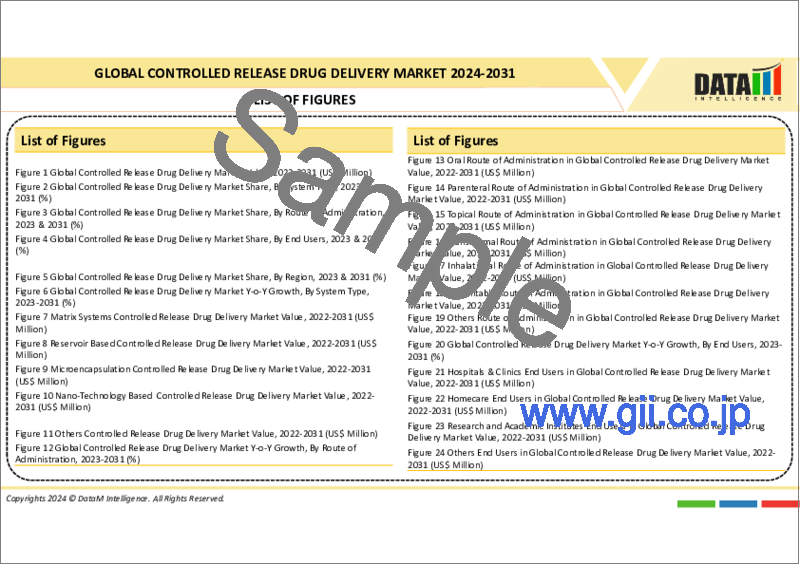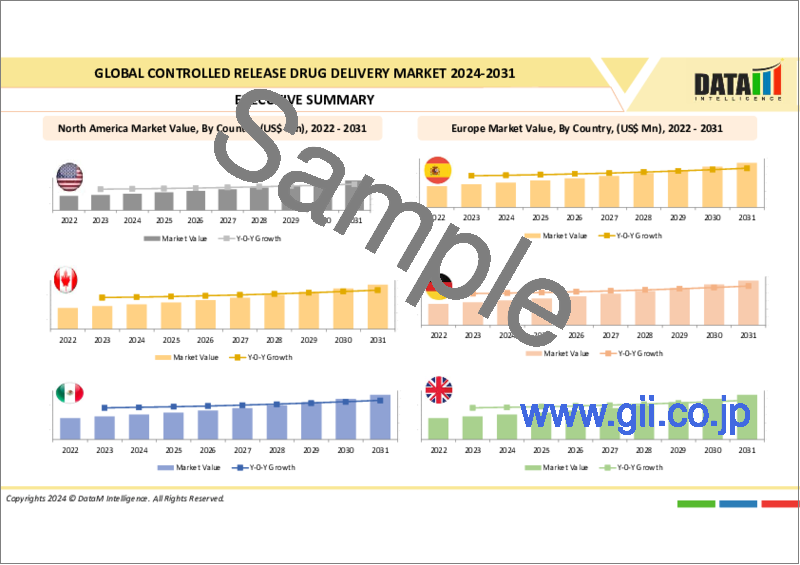|
|
市場調査レポート
商品コード
1316273
放出制御型ドラッグデリバリーの世界市場:2023年~2030年Global Controlled Release Drug Delivery Market - 2023-2030 |
||||||
カスタマイズ可能
適宜更新あり
|
|||||||
| 放出制御型ドラッグデリバリーの世界市場:2023年~2030年 |
|
出版日: 2023年07月27日
発行: DataM Intelligence
ページ情報: 英文 195 Pages
納期: 即日から翌営業日
|
- 全表示
- 概要
- 目次
市場概要
世界の放出制御型ドラッグデリバリー市場は、2022年に509億米ドルに達し、2030年には1,013億米ドルに達するなど、有利な成長が予測されています。世界の放出制御型ドラッグデリバリー市場は、予測期間中(2023~2030年)に9.2%のCAGRを示すと予測されています。
放出制御システムは、長期間にわたる薬剤の持続的かつ調節された放出を可能にします。この調節された放出は、治療薬の濃度を適切な範囲に保ち、治療効果を最大化するのに役立ちます。薬剤投与の頻度を減らし、継続的な薬剤供給を保証することで、患者のコンプライアンスを向上させ、より良い治療結果をもたらすことができます。
さらに、競争が激しく細分化された業界で事業を展開する製薬企業は、進化する市場の需要に積極的に対応し、放出制御型ドラッグデリバリー法の開発に継続的に投資してきた結果、需要を大幅に押し上げてきました。
市場力学
老年人口と小児人口の増加が市場成長を牽引
世界の老年人口と小児人口の増加は、市場拡大を促進する主な要因の1つです。老年人口は身体的、精神的、生物学的機能が低下しており、それが薬物使用に影響を及ぼしています。
例えば、WHOによれば、すべての国が、この人口動態の変化に対応できるような保健・社会システムを整備することは大きな課題です。2050年までに、高齢者の80%が低・中所得国に住むことになります。人口の高齢化率は、過去に比べてかなり高くなっています。
2020年には、60歳以上の人口が5歳未満の若者を上回る。2015年から2050年にかけて、世界人口に占める60歳以上の割合は12%から22%へとほぼ倍増します。その結果、高齢者人口の増加が市場拡大を後押しすることになります。
主要企業別取り組みと戦略の強化も市場成長の原動力
放出制御型医薬品の需要拡大に対応するため、主要企業が実施する活動や戦略の増加も市場拡大を後押しすると予測されます。例えば、ドイツの製薬会社Evonik Industries AGは2020年10月、吸収ウィンドウが狭い小腸上部の部位をターゲットとする経口医薬品の腸管吸収を改善する経口ドラッグデリバリー技術Eudratec Fastericを発表しました。
さらに、従来の器具を用いて迅速かつ効率的に処理でき、多剤形、錠剤、カプセル剤など幅広い経口投与形態に対応します。前述の要因により、市場は拡大すると思われます。
オンデマンド放出の欠如が市場成長の妨げとなる
オンデマンド放出制御型ドラッグデリバリーシステムの開発は技術的に困難です。特定の刺激や外部シグナルに反応して薬物放出を引き起こす高度なメカニズムを統合する必要があります。薬物の放出速度や投与量を正確に制御できるようなシステムの設計は複雑で、高度な材料技術や工学技術が必要になることが多いです。
オンデマンドの放出制御システムの開発には、特殊な材料、技術、製造プロセスが必要なため、コストがかかる場合があります。さらに、これらのシステムの複雑さは製造コストを上昇させる可能性があり、その結果、広く使用するための手頃な価格や入手しやすさが損なわれることになります。したがって、上記の要因が市場の成長を制限することになります。
COVID-19影響分析
COVID-19の流行は、放出制御型ドラッグデリバリーの分野にプラスとマイナスの両方の影響を与えています。COVID-19ワクチンの緊急の必要性に伴い、制御放出ワクチン送達システムの開発に大きな重点が置かれています。これらのシステムは、ワクチンの有効性を高め、必要な投与回数を減らし、患者のコンプライアンスを改善することを目的としています。
持続的な免疫反応をもたらし、頻繁なブースターの必要性をなくす長時間作用型ワクチン製剤の開発にも努力が払われています。パンデミックによって、ヘルスケアと製薬研究に対する資金と投資が増加しました。これにより、放出制御型ドラッグデリバリーシステムの開発に新たな機会が生まれました。
ロシア・ウクライナ紛争の影響分析
ロシア・ウクライナ紛争は、この地域の主要市場プレーヤーの数が少ないことから、世界の放出制御型ドラッグデリバリー市場への影響は中程度と推定されます。しかし、原材料の輸出入の影響は、予測期間中、世界の放出制御型ドラッグデリバリー市場の成長にほとんど影響を与えないと予想されます。
目次
第1章 調査手法と調査範囲
第2章 定義と概要
第3章 エグゼクティブサマリー
第4章 市場力学
- 影響要因
- 促進要因
- 慢性疾患の増加
- 主要企業による取り組みと戦略の強化
- 抑制要因
- オンデマンド・リリースの欠如
- 機会
- 医療インフラへのアクセスが限られている新興諸国
- 影響分析
- 促進要因
第5章 産業分析
- ポーターの5フォース分析
- サプライチェーン分析
- 価格分析
- 規制分析
第6章 COVID-19分析
第7章 リリースメカニズム別
- ポリマーベースのドラッグデリバリーシステム
- 活性化調節ドラッグデリバリーシステム
- 浸透圧ドラッグデリバリー
- 流体力学的圧力活性化ドラッグデリバリー
- 蒸気圧式ドラッグデリバリー
- 機械的活性化ドラッグデリバリー
- 化学的活性化ドラッグデリバリーシステム
- pH活性化ドラッグデリバリー
- 加水分解活性化ドラッグデリバリー
- 酵素活性化ドラッグデリバリー
第8章 技術別
- ウルスター法
- マイクロカプセル化
- コアセルベーション
- ターゲット・デリバリー
- その他
第9章 投与経路別
- 薬剤溶出ステント
- 眼インプラント
- 自動注射器/針なし注射器
- 鼻腔スプレー
- 輸液ポンプ
- その他
第10章 地域別
- 北米
- 米国
- カナダ
- メキシコ
- 欧州
- ドイツ
- 英国
- フランス
- スペイン
- イタリア
- その他欧州
- 南米
- ブラジル
- アルゼンチン
- その他南米
- アジア太平洋
- 中国
- インド
- 日本
- その他アジア太平洋地域
- 中東およびアフリカ
- 主な地域別ダイナミクス
第11章 競合情勢
- 競合シナリオ
- 市況/シェア分析
- M&A分析
第12章 企業プロファイル
- Johnson and Johnson.
- 会社概要
- 製品ポートフォリオと概要
- 財務概要
- 主な発展
- Coating Place, Inc
- Corium International, Inc
- Depomed, Inc
- Pfizer, Inc
- Biogen
- GlaxoSmithKline
- Novartis
- Orbis Biosciences, Inc.
- Merck and Co.
第13章 付録
Market Overview
The global controlled release drug delivery market reached US$ 50.9 billion in 2022 and is projected to witness lucrative growth by reaching up to US$ 101.3 billion by 2030. The global controlled release drug delivery market is expected to exhibit a CAGR of 9.2% during the forecast period (2023-2030).
Controlled release systems enable the sustained and regulated release of medications over a long period of time. This regulated distribution helps to keep therapeutic medication concentrations within the appropriate range, maximising therapy efficacy. It can increase patient compliance by reducing drug administration frequency and guaranteeing continuous drug supply, resulting in better therapeutic outcomes.
Additionally, pharmaceutical companies, who operate in a fiercely competitive and fragmented industry, have greatly boosted demand as a result of their proactive response to evolving market demands and continued investments in developing controlled-release drug delivery methods.
Market Dynamics
The Increasing Geriatric and Pediatric Population will Drive the Market Growth
The growing geriatric and paediatric population worldwide is one of the primary reasons driving market expansion, owing largely to non-adherence to prescription regimens, which is quite common among these age groups. Geriatric people have impaired physical, mental, and biological functioning, which affect their medication usage.
For instance, according to WHO, all countries have significant challenges in ensuring that their health and social systems are prepared to capitalise on this demographic transformation. By 2050, 80% of the elderly will live in low- and middle-income countries. The population is ageing at a considerably higher rate than in the past.
In 2020, the number of persons aged 60 and more will outnumber youngsters under the age of five. Between 2015 and 2050, the fraction of the global population over the age of 60 will nearly double, from 12% to 22%. As a result, the growing senior population will aid to boost market expansion.
Raising Initiatives And Strategies By the Key Companies also Drive the Market Growth
The increased activities and strategies implemented by key players to deal with the growing demand for controlled release medicine delivery are also predicted to fuel market expansion. For instance, in October 2020, Evonik Industries AG, a German pharmaceutical company, has introduced Eudratec Fasteric, an oral drug delivery technology that improves intestinal absorption for oral drug products that target sites in the upper small intestine with a narrow absorption window.
Furthermore, it can be processed rapidly and efficiently using conventional instruments and is compatible with a wide range of oral dose forms, including multiarticulate, tablets, and capsules. The market will expand as a result of the aforementioned factors.
Lack of On-Demand Release will Hamper the Market Growth
Developing on-demand controlled release drug delivery systems is technically challenging. It requires the integration of sophisticated mechanisms to trigger drug release in response to specific stimuli or external signals. Designing such systems with precise control over drug release rates and dosages is complex and often requires advanced materials and engineering techniques.
Developing on-demand controlled release systems can be costly due to the need for specialized materials, technologies, and manufacturing processes. Additionally, the complexity of these systems may increase the production costs, making them less affordable and accessible for widespread use. Thus, above factors will restrict the market growth.
COVID-19 Impact Analysis
The COVID-19 pandemic has had both positive and negative impacts on the field of controlled release drug delivery. With the urgent need for COVID-19 vaccines, there has been a significant emphasis on developing controlled release vaccine delivery systems. These systems aim to enhance vaccine efficacy, reduce the number of doses required, and improve patient compliance.
Efforts have been made to develop long-acting vaccine formulations that provide sustained immune response and eliminate the need for frequent boosters. The pandemic has led to increased funding and investment in healthcare and pharmaceutical research. This has created new opportunities for the development of controlled release drug delivery systems.
Russia-Ukraine War Impact Analysis
The Russia-Ukraine conflict is estimated to have a moderate impact on the global controlled release drug delivery market, owing to the low number of key market players in this region. However, the impact of the import and export of raw materials is expected to have little influence over the global controlled release drug delivery market growth over the forecast period.
Segment Analysis
The global controlled release drug delivery market is segmented based on release mechanism, technology, route of administration and region.
Auto-injectors/Needle-free injectors from Route of Administration Segment Aaccounts for 30.7% of Market Share Owing to Rising Novel Product Launches
During the projection period, targeted drug delivery is expected to dominate the market. This is mainly due to expanding demand, as well as a growing geriatric and paediatric population. For instance, In 2021, there were about 26.2 million children between the ages of 12 and 17 years old living in the United States. On the other hand, there were about 22.9 million children between the ages of zero and five years old in the country.
Additionally, when compared to typical delivery methods, targeted delivery systems achieve a longer therapeutic effect by delivering medications at the target site at predetermined drug release kinetics. Furthermore, the increasing number of product launches as a result of the increased benefits afforded by targeted delivery are likely to support the segment's growth.
Geographical Analysis
Europe Accounted for Approximately 27.4% of the Market Share
Due to increased R&D efforts and the presence of large pharmaceutical companies in the region. With an increase in patients suffering from chronic diseases such as cancer, diabetes, and COPD, the regional market is expected to grow steadily in the next years.
For instance, according to EUROSTAT, In 2020, cancer was the second highest cause of death in the EU, accounting for 1.2 million deaths, or 23.0% of all deaths in the EU. Cancer claimed a greater share of male mortality (24.9%) than female deaths (20.0%). As a result, the previously mentioned factors will dominate market growth.
Competitive Landscape
The major global players in the controlled release drug delivery market include: Johnson and Johnson, Coating Place, Inc, Corium International, Inc, Depomed, Inc, Pfizer, Inc, Biogen, GlaxoSmithKline, Novartis, Orbis Biosciences, Inc., Merck and Co among others.
Why Purchase the Report?
- To visualize the global controlled release drug delivery market segmentation based on release mechanism, technology, route of administration and region,as well as understandkey commercial assets and players.
- Identify commercial opportunities by analyzing trends and co-development.
- Excel data sheet with numerous data points of controlled release drug delivery market-level with all segments.
- PDF report consists of a comprehensiveanalysis after exhaustive qualitative interviews and an in-depth study.
- Product mapping available asexcelconsisting of key products of all the major players.
The global controlled release drug delivery market report would provide approximately 53 tables, 54 figures and 195 Pages.
Target Audience 2023
- Manufacturers/ Buyers
- Industry Investors/Investment Bankers
- Research Professionals
- Emerging Companies
Table of Contents
1. Methodology and Scope
- 1.1. Research Methodology
- 1.2. Research Objective and Scope of the Report
2. Definition and Overview
3. Executive Summary
- 3.1. Snippet by Release Mechanism
- 3.2. Snippet by Technology
- 3.3. Snippet by Route of Administration
- 3.4. Snippet by Region
4. Dynamics
- 4.1. Impacting Factors
- 4.1.1. Drivers
- 4.1.1.1. Increase in prevalence of chronic diseases
- 4.1.1.2. Raising initiatives and strategies by the key companies
- 4.1.2. Restraints
- 4.1.2.1. Lack of On-Demand Release
- 4.1.3. Opportunity
- 4.1.3.1. Developing countries with limited access to healthcare infrastructure
- 4.1.4. Impact Analysis
- 4.1.1. Drivers
5. Industry Analysis
- 5.1. Porter's 5 Forces Analysis
- 5.2. Supply Chain Analysis
- 5.3. Pricing Analysis
- 5.4. Regulatory Analysis
6. COVID-19 Analysis
- 6.1. Analysis of COVID-19
- 6.1.1. Scenario Before COVID-19
- 6.1.2. Scenario During COVID-19
- 6.1.3. Scenario Post COVID-19
- 6.2. Pricing Dynamics Amid COVID-19
- 6.3. Demand-Supply Spectrum
- 6.4. Government Initiatives Related to the Market During Pandemic
- 6.5. Manufacturers Strategic Initiatives
- 6.6. Conclusion
7. By Release Mechanism
- 7.1. Introduction
- 7.1.1. Market Size Analysis and Y-o-Y Growth Analysis (%), By Release Mechanism
- 7.1.2. Market Attractiveness Index, By Release Mechanism
- 7.2. Polymer-based drug delivery system*
- 7.2.1. Introduction
- 7.2.2. Market Size Analysis and Y-o-Y Growth Analysis (%)
- 7.3. Activation modulated drug delivery system
- 7.3.1. Osmotic pressure activated drug delivery
- 7.3.2. Hydrodynamic pressure activated drug delivery
- 7.3.3. Vapor pressure activated drug delivery
- 7.3.4. Mechanically activated drug delivery
- 7.4. Chemically activated drug delivery system
- 7.4.1. pH activated drug delivery
- 7.4.2. Hydrolysis activated drug delivery
- 7.4.3. Enzyme activated drug delivery
8. ByTechnology
- 8.1. Introduction
- 8.1.1. Market Size Analysis and Y-o-Y Growth Analysis (%), By Technology
- 8.1.2. Market Attractiveness Index, By Technology
- 8.2. Wurster technique*
- 8.2.1. Introduction
- 8.2.2. Market Size Analysis and Y-o-Y Growth Analysis (%)
- 8.3. Micro encapsulation
- 8.4. Coacervation
- 8.5. Targeted delivery
- 8.6. Others
9. By Route of Administration
- 9.1. Introduction
- 9.1.1. Market Size Analysis and Y-o-Y Growth Analysis (%), By Route of Administration
- 9.1.2. Market Attractiveness Index, By Route of Administration
- 9.2. Drug-eluting stents*
- 9.2.1. Introduction
- 9.2.2. Market Size Analysis and Y-o-Y Growth Analysis (%)
- 9.3. Ocular implants
- 9.4. Auto-injectors/ Needle-free injectors
- 9.5. Nasal sprays
- 9.6. Infusion pumps
- 9.7. Others
10. By Region
- 10.1. Introduction
- 10.1.1. Market Size Analysis and Y-o-Y Growth Analysis (%), By Region
- 10.1.2. Market Attractiveness Index, By Region
- 10.2. North America
- 10.2.1. Introduction
- 10.2.2. Key Region-Specific Dynamics
- 10.2.3. Market Size Analysis and Y-o-Y Growth Analysis (%), By Release Mechanism
- 10.2.4. Market Size Analysis and Y-o-Y Growth Analysis (%), By Technology
- 10.2.5. Market Size Analysis and Y-o-Y Growth Analysis (%), By Route of Administration
- 10.2.6. Market Size Analysis and Y-o-Y Growth Analysis (%), By Country
- 10.2.6.1. U.S.
- 10.2.6.2. Canada
- 10.2.6.3. Mexico
- 10.3. Europe
- 10.3.1. Introduction
- 10.3.2. Key Region-Specific Dynamics
- 10.3.3. Market Size Analysis and Y-o-Y Growth Analysis (%), By Release Mechanism
- 10.3.4. Market Size Analysis and Y-o-Y Growth Analysis (%), By Technology
- 10.3.5. Market Size Analysis and Y-o-Y Growth Analysis (%), By Route of Administration
- 10.3.6. Market Size Analysis and Y-o-Y Growth Analysis (%), By Country
- 10.3.6.1. Germany
- 10.3.6.2. U.K.
- 10.3.6.3. France
- 10.3.6.4. Spain
- 10.3.6.5. Italy
- 10.3.6.6. Rest of Europe
- 10.4. South America
- 10.4.1. Introduction
- 10.4.2. Key Region-Specific Dynamics
- 10.4.3. Market Size Analysis and Y-o-Y Growth Analysis (%), By Release Mechanism
- 10.4.4. Market Size Analysis and Y-o-Y Growth Analysis (%), By Technology
- 10.4.5. Market Size Analysis and Y-o-Y Growth Analysis (%), By Route of Administration
- 10.4.6. Market Size Analysis and Y-o-Y Growth Analysis (%), By Country
- 10.4.6.1. Brazil
- 10.4.6.2. Argentina
- 10.4.6.3. Rest of South America
- 10.5. Asia-Pacific
- 10.5.1. Introduction
- 10.5.2. Key Region-Specific Dynamics
- 10.5.3. Market Size Analysis and Y-o-Y Growth Analysis (%), By Release Mechanism
- 10.5.4. Market Size Analysis and Y-o-Y Growth Analysis (%), By Technology
- 10.5.5. Market Size Analysis and Y-o-Y Growth Analysis (%), By Route of Administration
- 10.5.6. Market Size Analysis and Y-o-Y Growth Analysis (%), By Country
- 10.5.6.1. China
- 10.5.6.2. India
- 10.5.6.3. Japan
Australia
- 10.5.6.4. Rest of Asia-Pacific
- 10.6. Middle East and Africa
- 10.6.1. Introduction
- 10.6.2. Key Region-Specific Dynamics
- 10.6.3. Market Size Analysis and Y-o-Y Growth Analysis (%), By Release Mechanism
- 10.6.4. Market Size Analysis and Y-o-Y Growth Analysis (%), By Technology
- 10.6.5. Market Size Analysis and Y-o-Y Growth Analysis (%), By Route of Administration
11. Competitive Landscape
- 11.1. Competitive Scenario
- 11.2. Market Positioning/Share Analysis
- 11.3. Mergers and Acquisitions Analysis
12. Company Profiles
- 12.1. Johnson and Johnson.*
- 12.1.1. Company Overview
- 12.1.2. ProductPortfolio and Description
- 12.1.3. Financial Overview
- 12.1.4. Key Developments
- 12.2. Coating Place, Inc
- 12.3. Corium International, Inc
- 12.4. Depomed, Inc
- 12.5. Pfizer, Inc
- 12.6. Biogen
- 12.7. GlaxoSmithKline
- 12.8. Novartis
- 12.9. Orbis Biosciences, Inc.
- 12.10. Merck and Co.
LIST NOT EXHAUSTIVE
13. Appendix
- 13.1. About Us and Services
- 13.2. Contact Us






